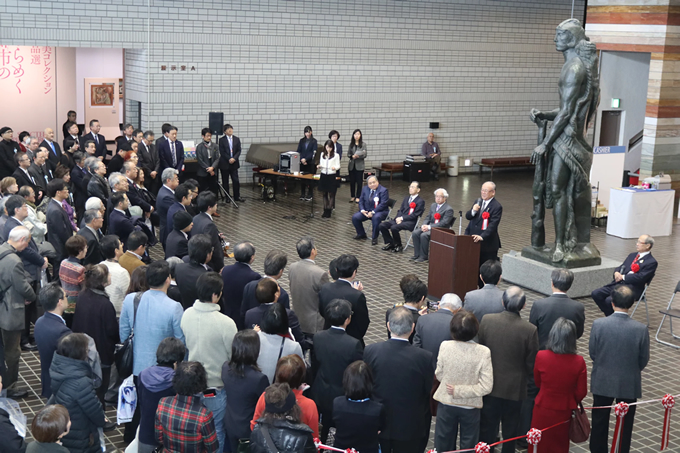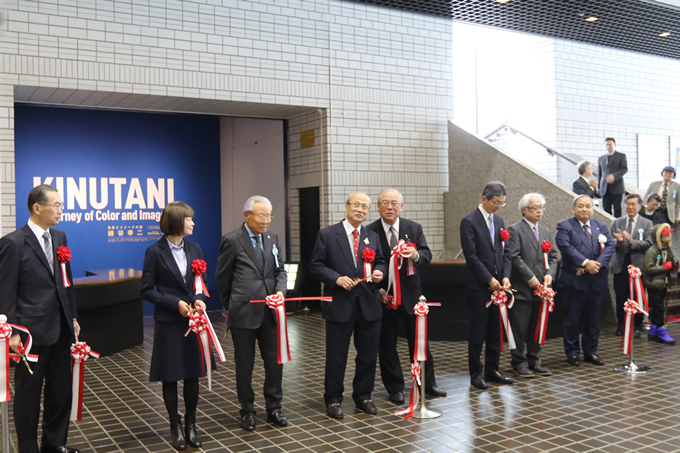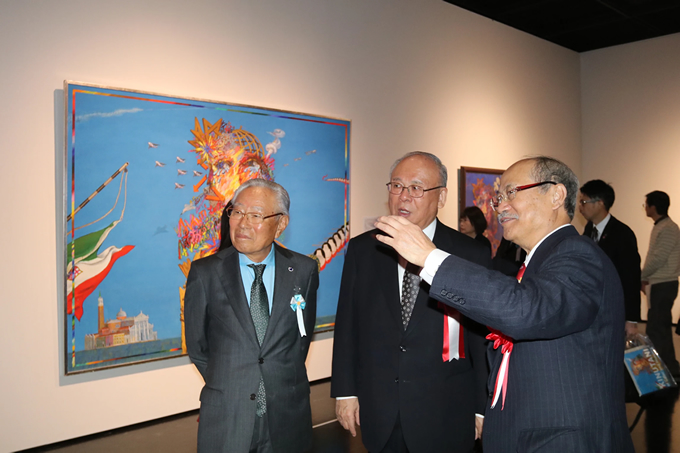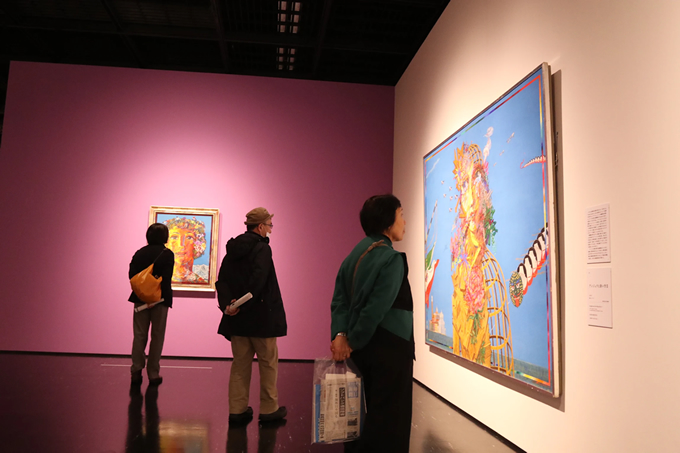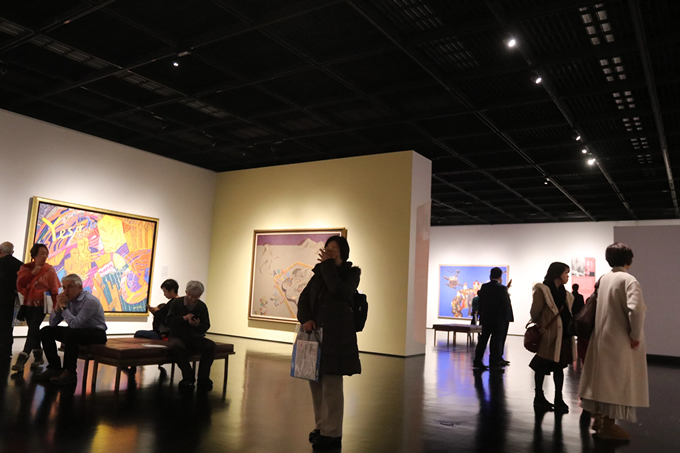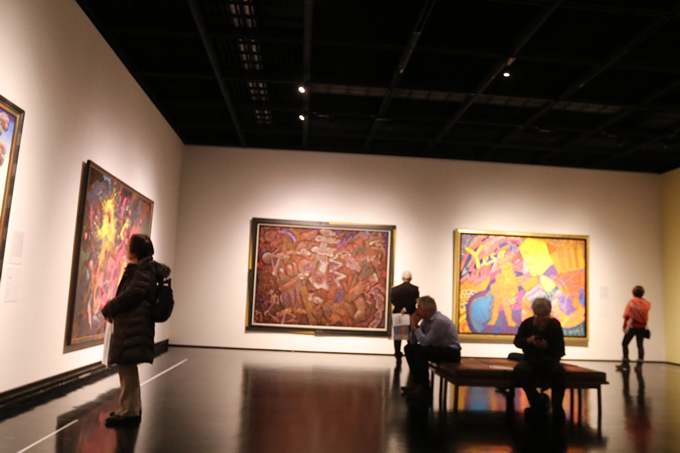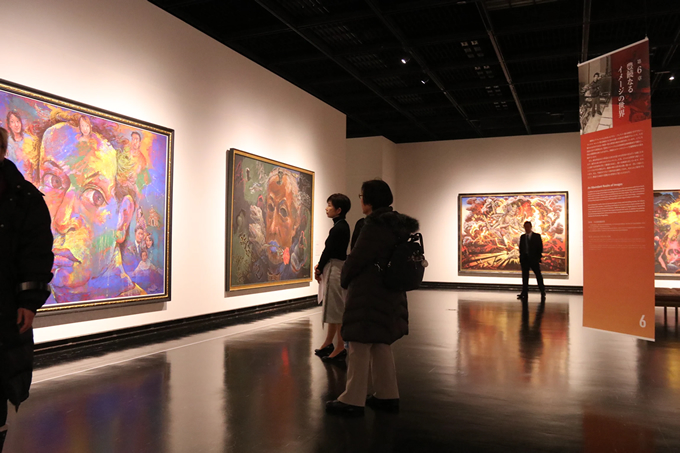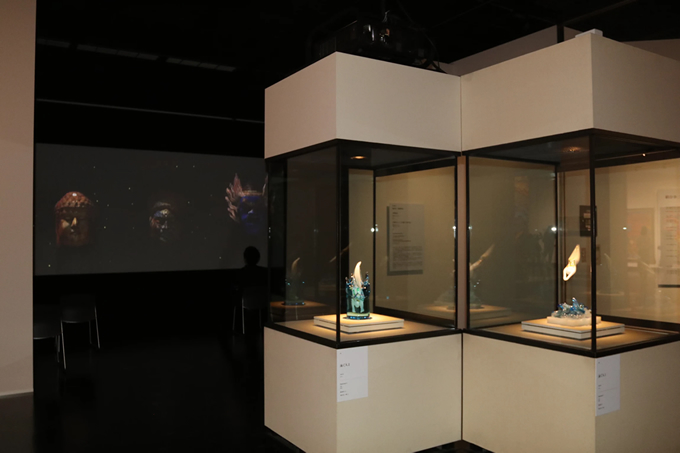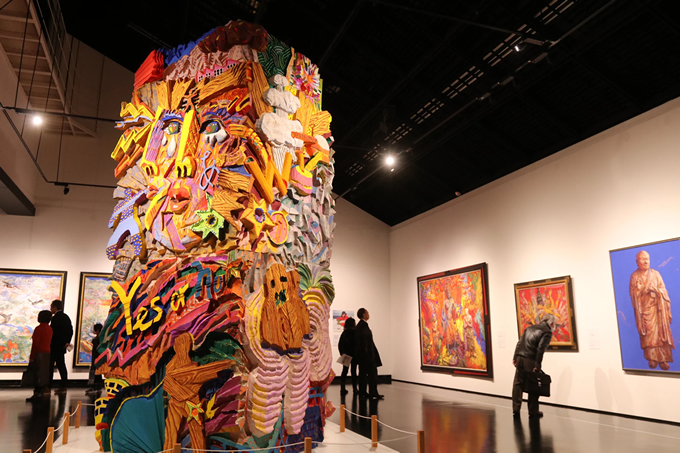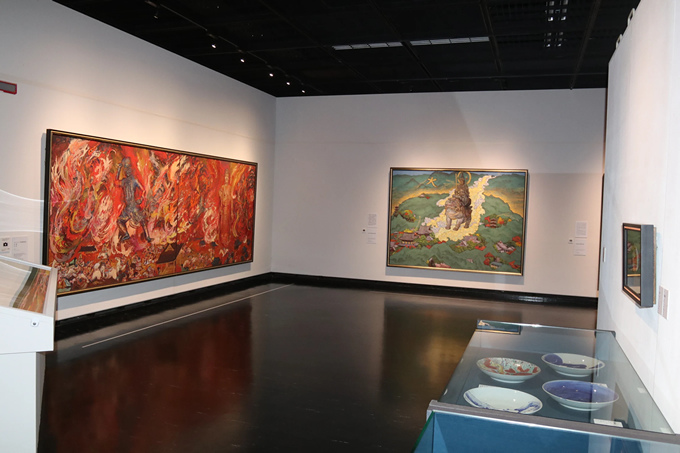北海道立近代美術館Hokkaido Museum of Modern Art
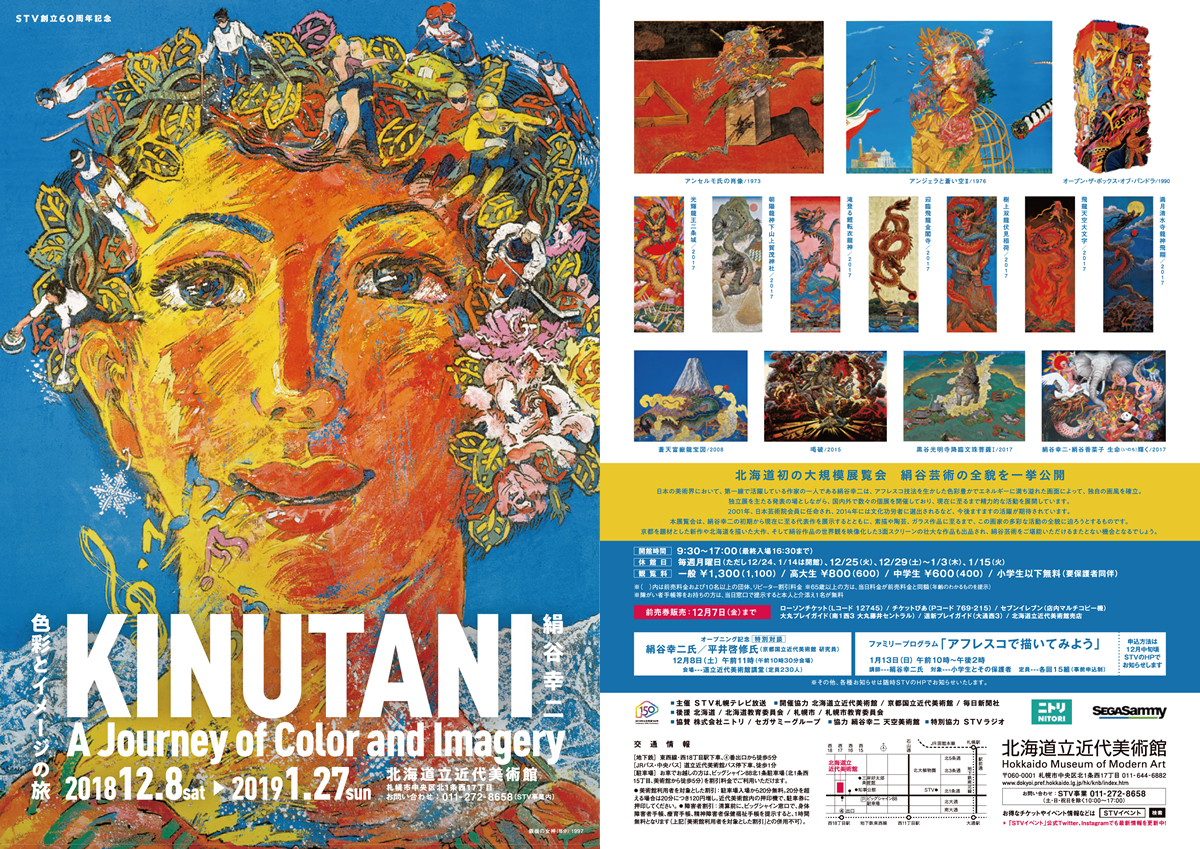
- リーフレットLeaflet
- https://kinutani.jp/images/hokkaido/20181208.pdf
- PR動画PR Video
-
- 2018年12月8日 特別対談動画December 8, 2018 Special talk video
-
2018年12月8日 特別対談動画
絹谷幸二氏/平井啓修氏(京都国立近代美術館 研究員) 約70分
December 8, 2018 Special talk video - フォトギャラリーPhoto Gallery
- 会場Venue
- 北海道立近代美術館|Hokkaido Museum of Modern Art
- 会期Exhibition dates
- 2018年12月8日(土)~2019年1月27日(日)|December 8 (Sat.) 2018- January 27 (Sun.), 2019
- 開館時間Hours
- 午前9時30分~午後5時(最終入場は16:30まで)|Regular hours 9:30AM - 5:00PM (admission until 4:30PM)
- 休館日Closed
- 毎週月曜日、12月25日(月)、12月29日(土)~1月3日(木)、1月15日(火)|Mondays, December 29(Sat.) - January 3(Thu.) and January 15(Tue.)
- ※ただし12月24日(月)、1月14日(月)は開館|Exception: December 24 (Mon.) and January 14 (Mon.)
- 主催Organizer
- STV札幌テレビ放送|STV The Sapporo Television Broadcasting
- 開催協力Organizer
- 北海道立近代美術館|Hokkaido Museum of Modern Art
京都国立近代美術館|The National Museum of Modern Art, Kyoto
毎日新聞社|The Mainichi Newspapers - 後援Support
- 北海道|Hokkaido
北海道教育委員会|Hokkaido Board of Education
札幌市|Sapporo City
札幌市教育委員会|Sapporo City Board of Educatio - 協賛Sponsorship
- 株式会社ニトリ|Nitori Co., Ltd.
セガサミーグループ|SEGA SAMMY HOLDINGS inc. - 協力Cooperation
- 絹谷幸二 天空美術館|Koji Kinutani Tenku Art Museum
- 観覧料Admission
-
※ 小学生以下は無料(要保護者同伴)。当日 前売り 団体(10名以上) 一 般 1,300 1,100 1,100 高大生 800 600 600 中学生 600 400 400
※ 10名以上の団体、リピーター割引料金は前売料金と同額
※ 65歳以上の方は、当日料金が前売料金と同額(年齢のわかるものを提示)
※ 心身に障がいのある方と付添者1名は無料(入館の際に証明できるものをご提示下さい)。
※ 前売券は、7月20日(金)から12月7日(金)までの期間限定発売。
※ チケット販売所:
・ローソンチケット(前売券 Lコード:12745)
・チケットぴあ(前売券 Pコード:769-215)
・セブン-イレブン
・道新プレイガイド(札幌市中央区大通西3丁目 TEL:011-241-3871)
・大丸プレイガイド(札幌市中央区南1条西3丁目大丸藤井セントラル1F TEL:011-221-3900)
・北海道立近代美術館売店
* Elementary school students and under are freeDay of admission Advance Group (10 or more) Adult 1,300 1,100 1,100 High school and university students 800 600 600 Middle school students 600 400 400
* Visitors with disability and one person accompanying them are admitted free of charge. (Please present certificate at the admission.)
* Advance tickets are available between July 20 - December 7, 2018 - 所在地Location
- 北海道立近代美術館|Hokkaido Museum of Modern Art
〒060-0001 札幌市中央区北1条西17丁目|17, Kita1-jonishi, Chuo-ku Sapporo-shi, Hokkaido, 060-0001, Japan - アクセスマップAccess map
- 展覧会への寄稿文Texts on the Exhibition
-
建畠 晢(多摩美術大学学長/埼玉県立近代美術館館長)「絹谷幸二の世界」(展覧会カタログ『絹谷幸二 色彩とイメージの旅』掲載)
画家は段階的に作風を形成していくことが多いが、機が熟した時、一挙に自らの世界を確立してみせる画家もいないわけではない。若くして安井賞を受賞した絹谷幸二もその一人で、アフレスコ・ストラッポによる受賞作<アンセルモ氏の肖像>(1973年)において彼は今日までの長い画業を貫いてきた独自のパッショネイトな表現を典型的なかたちで出現させたのである。それは大きな飛躍でありながらも、イタリアにおける技法的、色彩的、形象的な探究の結節点とも見なしうる、まさにモニュメンタルな意味をもった作品であったといわなければなるまい。
輪郭線で稲妻のように切り取られた流動的なスピード感に満ちた形象が登場してきたこと、赤を基調にした鮮烈な色彩が用いられていること、一種神話的なイメージの創出のエネルギーにあふれていると同時に、どこか崩壊や破壊の感覚を宿してもいること。オブジェや光景の捉え方に密かにキリコの形而上学的絵画にも通じるところがあること。そして不可思議な謎をはらんだ、絹谷ならではのユーモラスなポップ感覚。
こうしたユニークな特質は宇宙大のスケールへと拡大されながらも、基本的には最近作に至るまで維持されてきているものである。今回の回顧展が「色彩とイメージの旅」と題されているのも、絹谷の制作の軌跡が、きわめて豊饒な多様性を有しながらも、安井賞の時点で自らの資質を見極め、画家としての一筋の道を歩むことであったという自負心を表しているのかもしれない。ちなみに<アンセルモ氏>とはベネチア留学中に彼が親しくしていた画家で、周囲から注目されながらもなぜか画業を離れ、やがてインドで消息を絶ったという。画面の顔がもはや肖像といいえぬほどに崩壊しつつあるのも、絵筆による予感であったと絹谷は記している。
生成と崩壊の感覚が共存するということは、見方によっては絹谷の作品は愛と死の、あるいは絶望と救済の両義性をはらんでいるということでもあるだろう。私たちが絹谷の世界に魅せられて止まないのは、実はバイタリティーに満ちた華麗なる表現の背後にある、陰の部分をも見据える画家の思索の深さのゆえであるのかもしれない。たとえば<砂の中>(1982年)では赤い砂漠の大地で柩のような箱の中に横たわって愛し合う男女が描かれている。傍らに砲弾のごときものが転がっているからには、ここは戦場であろうか。箱の内側にはひらがなが、砂地の上には"無"の字や般若心経の断片が配されている。そこに直線的なストーリーが読み取れるわけではないが、私には不寛容さによる紛争が絶えない状況にあって、愛に希望を託す画家の祈りが静かに伝わってくるように思われたのである。
<ノン・ディメンティカーレ(忘れないで)>(1994年)は絹谷にしては珍しく色彩は暗く抑制され(といっても赤や青は部分的に使用されているが)、戦争による破壊や殺戮、廃墟の光景が大画面にびっしりと描き込まれている。下辺には"PIKKA DON"の文字も見られる。この画家は絵画は審美的に鑑賞されるばかりではなく、いやむしろそうであるからこそ、絵筆によってしか伝えることのできないメッセージを有していると考えているに違いない。その意味では彼の作品はいかにポップ的な現代性を帯びてはいても、宗教画な思索とも無縁ではないところに位置しているのである。
もう一つ注目されてよいのは、アフレスコ・ストラッポをはじめとする絵画の技法への探求が、1980年代後半になるとスティロフォームによる立体作品を派生させていくことである。<オープン・ザ・ボックス・オブ・パンドラ>(1990年を見れば分かるように、イメージの断片化、色彩の豊潤さ、文字の導入、構築性と破壊などの<アンセルモ氏の肖像>以来の特質は絵画からそのまま持ち込まれ、しかもより混沌とした趣を強めているのだ。まさにパンドラの箱を開けたように、である。
さて、昨年末、大阪の梅田に「絹谷幸二 天空美術館」がオープンした。館名通り、大阪の街を見下ろすビルの高層階に位置する美術館で、展示は近作、新作を中心としているが、私にとってもっとも興味深かったのは3Dの映像の上映であった。卓抜な技術によって、富士山や風神雷神の図などの世界に突入して行く体験が可能になり、イメージがダイナミックに連鎖するこの画家ならではの流動的な画面が大胆に拡大され、また神話的な物語性や宇宙感覚などを生かすなど、映像に絵画を取り込むという困難なだけにスリリングでもある実験に成功していた。絹谷の広範な制作の軌跡を一望できる本展に期待するとともに、新たに試みられると聞く映像も楽しみにしたい。Akira Tatehata(President, Tama Art University / Director, The Museum of Modern Art, Saitama) , "The World of Koji Kinutani" (Published in the exhibition catalog, Koji Kinutani A Journey of Color and Imagery)
Although painters usually develop their style gradually, there are some who succeed, when the time is ripe, in suddenly establishing a world of their own. Among them is Koji Kinutani, who won the prestigious Yasui Prize at a young age. With the prizewinning work Portrait of Mr. Anselmo (1973), which employs the technique of fresco strappo (removing the paint layer of a wall fresco and applying it to another support), he embarked on a long journey that continues to this day, in which he makes unique and passionately expressive use of a classical medium. The 1973 work represents a spontaneous creative leap, and at the same time it is of monumental significance as a consolidation of his technical, chromatic, and graphic explorations carried out in Italy.
The emergence of dynamic forms with a strong sense of velocity, surrounded by contour lines resembling strokes of lightning, the vivid palette with red as a base tone, the somehow mythological imagery that is both overflowing with energy and imbued with a sense of collapse and destruction. Such depiction of objects and scenes is closely connected to the metaphysical painting of Giorgio de Chirico. Kinutani's distinctive, humorous Pop sensibility is full of mystery and wonder.
These unique qualities have essentially remained in Kinutani's work until recently, although they have grown in scale over the years until they seem to encompass an entire universe. This retrospective is subtitled A Journey of Color and Imagery, perhaps reflecting the artist's recognition that he has trod a single path since ascertaining his own artistic qualities with his receipt of the Yasui Prize, although it has been an exceedingly diverse and fertile one. Incidentally, the Mr. Anselmo of the painting was a painter with whom Kinutani was close friends when he was studying abroad in Italy, and although he was gaining some recognition as an artist, he for some reason gave up painting and went to India, where he disappeared. His face in the painting is so deconstructed that it can hardly be called a portrait, and Kinutani has written that his brush may have foreseen Anselmo's fate.
Depending on one's viewpoint, the coexistence of generative and disintegrative forces in a single painting could indicate that Kinutani's work is imbued with the ambiguity of love and death, despair and salvation. Kinutani's world may fascinate us because of the artist's depth of thought, the way he peers into the shadows lurking behind the brilliant, vital scenes he depicts. NELLA SABBIA(in the Sand)(1982), for example, depicts a man and a woman lying entwined in an embrace in a coffin-like box lying amid the red desert sands. Objects resembling shells are lying around them, indicating that this may be battlefield. Hiragana are written on the inside of the box, and the kanji mu (nothing) and fragments of the Heart Sutra are inscribed on the sand. We cannot read any story directly, but the painting quietly conveys the artist's prayers that love will conquer in a world constantly wracked by wars springing from intolerance.
Non Dimenticare (Do not Forget)(1994) is anomalous among Kinutani's works for its dark, somber tones(although red and blue are partially used), and the large canvas presents a vista of destruction, massacre, ruins and other horrors of war. The words pika don (an onomatopoetic representation of the atomic bomb's light and sound) are written near the bottom. Despite, or perhaps because of, the fact that the artist's works are often viewed with an aesthetic and sensual eye, the work delivers a message that could only be delivered through brushwork. In this sense, Kinutani's paintings have an affinity with religious art and the philosophy attending it, no matter how contemporary and "Pop" a sensibility they may present.
Another notable point is that Kinutani's exploration of painting techniques like fresco strappo later led to his three-dimensional Styrofoam works in the late 1980s. A work such as Open Pandora's Box (1990) displays characteristics evident since the era of Portrait of Mr. Anselmo, such as fragmented images, saturated color, inclusion of text, and elements of construction and destruction, and is even more powerfully chaotic. Indeed, it is just like opening Pandora's box.
At the end of 2016, the Koji Kinutani Tenku Art Museum opened in Umeda, Osaka. It is located on a high floor of a building overlooking the city of Osaka, and primarily features new and recent works. What fascinates me the most is the screening of 3D images. Through state-of-the-art technology, viewers can be immersed in a world of imagery such as Mount Fuji and the Wind and Thunder Gods, with mythological narrative and galactic scale, where paintings featuring fluid, dynamically linked images such as only this artist could create are boldly enlarged. Kinutani has succeeded in a challenging, and thus thrilling experiment in incorporating painting into video. I look forward to seeing these new experiments with the moving image, as well as the overview of the arc of Kinutani's great, long and diverse journey that this exhibition offers.
